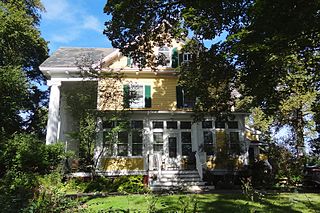
Highland Park is a borough in Middlesex County, New Jersey, United States in the New York City metropolitan area. The borough is located on the northern banks of the Raritan River, in the Raritan Valley region. As of the 2020 United States Census, the borough's population was 15,072, reflecting an increase (7.28%) from the 2010 United States Census.

New Brunswick is a city in and the county seat of Middlesex County, New Jersey. The city is the home of Rutgers University. The city is both a regional commercial hub for central New Jersey and a prominent and growing commuter town for residents commuting to New York City within the New York metropolitan area. New Brunswick is on the Northeast Corridor rail line, 27 miles (43 km) southwest of Manhattan. The city is located on the southern banks of the Raritan River in the Raritan Valley region.

New Brunswick Theological Seminary is a Reformed Christian seminary with its main campus in New Brunswick, New Jersey. It was founded in 1784 and is the oldest seminary extant in the United States. It is one of two operated by the Reformed Church in America (RCA), a mainline Reformed Protestant denomination in Canada and the United States that follows the theological tradition and Christian practice of John Calvin. First established in New York City under the leadership of the Rev. John Henry Livingston, who instructed aspiring ministers in his home, the seminary established its presence in New Brunswick in 1810. Although a separate institution, the seminary's early development in New Brunswick was closely connected with that of Rutgers University before establishing its own campus in the city in 1856. Since 1986, the seminary has also offered classes at a satellite location on the grounds of St. John's University in the Jamaica neighborhood of Queens, New York.

Buccleuch Mansion is located in Buccleuch Park in New Brunswick in Middlesex County, New Jersey, along the Raritan River.
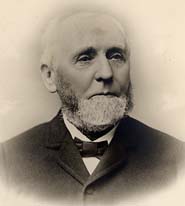
George Hammell Cook was the state geologist of New Jersey and vice president of Rutgers College. His geological survey of New Jersey became the predecessor for the U.S. Geological Survey.
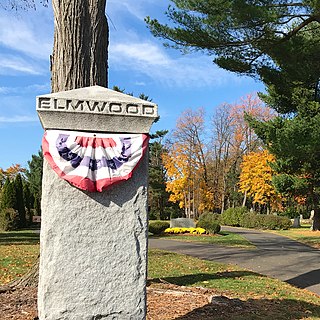
The Elmwood Cemetery is located at 425 Georges Road in North Brunswick, Middlesex County, New Jersey. It borders New Brunswick, New Jersey. The cemetery was established in 1868.
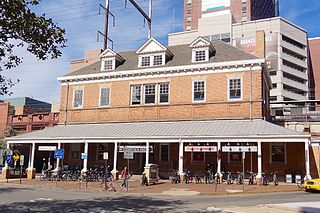
New Brunswick station is a railroad station in New Brunswick, New Jersey. It serves Amtrak and NJ Transit trains on the Northeast Corridor. The station is located at the intersection of Easton Avenue and French and Albany Streets, near the College Avenue Campus of Rutgers University.

The Henry Guest House is in New Brunswick, Middlesex County, New Jersey, at Livingston Avenue and Morris Street. It was originally located on New Street between Livingston Avenue and George Street. The Georgian stone farmhouse was built in 1760 by Henry Guest. He was a New Brunswick alderman and an associate of John Adams and author Thomas Paine. It was added to the National Register of Historic Places on May 24, 1976.

Old Queens is the oldest extant building at Rutgers University and is the symbolic heart of the university's campus in New Brunswick in Middlesex County, New Jersey in the United States. Rutgers, the eighth-oldest college in the United States, was founded in 1766 during the American colonial period as Queen's College. Queen's College was named for Charlotte of Mecklenburg-Strelitz, the daughter of a German duke who became the queen consort of British king George III. Old Queens is located on a six-acre hilltop city block bounded by Somerset Street, Hamilton Street, College Avenue and George Street that was previously an apple orchard. Donated to the college in 1807 by James Parker, Jr., this city block become known the Queen's Campus and is the historic core of the university. Because of this, by metonymy, the name "Old Queens" came to be used as a reference to Rutgers College and is often invoked as an allusive reference to the university or to its administration.

Voorhees Mall is a large grassy area with stately shade trees on a block of about 28 acres (0.11 km²) located on the College Avenue Campus of Rutgers University near downtown New Brunswick, New Jersey. An eclectic mix of architectural styles, Voorhees Mall is lined by many historic academic buildings. The block is bound by Hamilton Street, George Street (north), College Avenue (south) and Seminary Place (west). At the mall's western end, across Seminary Place, is the campus of the New Brunswick Theological Seminary, whose history is intertwined with the early history of Rutgers University. Across Hamilton Street is the block called Old Queens, the seat of the university.

The Eagleton Institute of Politics at Rutgers University was established in 1956 with an endowment from Florence Peshine Eagleton (1870–1953), and it focuses on state and national politics through education and public service. Ruth Mandel served as director for over 20 years, before being succeeded in that role by John Farmer Jr. in September, 2019.

The Sophia Astley Kirkpatrick Memorial Chapel, known as Kirkpatrick Chapel, is the chapel to Rutgers, The State University of New Jersey and located on the university's main campus in New Brunswick, New Jersey in the United States. Kirkpatrick Chapel is among the university's oldest extant buildings, and one of six buildings located on a historic section of the university's College Avenue Campus in New Brunswick known as the Queens Campus. Built in 1872 when Rutgers was a small, private liberal arts college, the chapel was designed by architect Henry Janeway Hardenbergh at the beginning of his career. Hardenbergh, a native of New Brunswick, was the great-great-grandson of Rutgers' first president, the Rev. Jacob Rutsen Hardenbergh. It was the third of three projects that Hardenbergh designed for the college.

Geology Hall is a historic building on the Queens Campus of Rutgers University, in New Brunswick, New Jersey. It was built from April 1871 to June 1872 to house various science classes and the Rutgers Geology Museum. The museum was established in 1872 by George Hammell Cook, Rutgers' then professor of geology, with a collection of specimens whose assembly began in the 1830s under Cook's predecessor, Lewis Caleb Beck. As classes and offices moved out of the hall, the museum expanded until it occupied the entire hall by the mid-20th century. In 1973, the hall was added to the New Jersey and National Register of Historic Places (NRHP) with Old Queens, President's House, Van Nest Hall, Daniel S. Schanck Observatory, the Kirkpatrick Chapel, and Winants Hall as part of the Old Queens Campus historic district.

Alexander Johnston Hall is a historic building located on the corner of Somerset Street and College Avenue, New Brunswick in Middlesex County, New Jersey and is the second oldest building on the campus of Rutgers University. It was built in 1830 to handle the expansion of the Rutgers Preparatory School and the two literary societies, Philoclean and Peithessophian. The building, described using its historic name, Rutgers Preparatory School, was added to the National Register of Historic Places on July 18, 1975 for its significance in architecture and education.
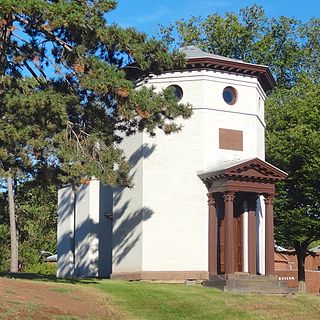
The Daniel S. Schanck Observatory is an historical astronomical observatory on the Queens Campus of Rutgers University in New Brunswick, New Jersey, United States, and is tied for the seventh oldest observatory in the US alongside the Vassar College Observatory. It is located on George Street near the corner with Hamilton Street, opposite the parking lot adjacent to Kirkpatrick Chapel, and to the northeast of Old Queens and Geology Hall.

The Queens Campus or Old Queens Campus is a historic section of the College Avenue Campus of Rutgers, The State University of New Jersey in New Brunswick, New Jersey, in the United States.

New Jersey Hall is a historic education building located on the campus of Rutgers University in New Brunswick, New Jersey. Built in 1889 under the leadership of President Merrill Edward Gates, it housed the Agricultural Experiment Station.
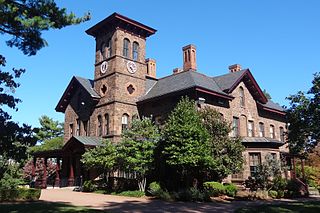
The Levi D. Jarrard House is a historic building located on the Douglass College campus of Rutgers University in New Brunswick, New Jersey. It was constructed in 1868 by an unknown architect, as a private residence for Levi D. Jarrard. Levi D Jarrard, was acting as Postmaster of New Brunswick from 1881-1883, but was previously employed as a New Jersey State Senator as well as the Middlesex County Collector. In 1883 he was found to have embezzled approximately $20,000, and had fled to Canada with the funds, leaving his family to struggle with payments on the house. The house was then purchased by John N. Carpender, who would later lease it to the New Jersey College for Women.
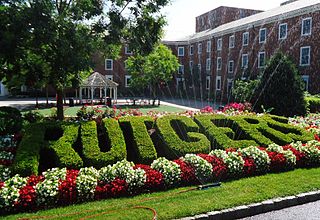
College Avenue is the oldest campus of Rutgers University – New Brunswick, in New Brunswick, New Jersey, U.S. It includes the historic seat of the university, known as Old Queens and the campus of the New Brunswick Theological Seminary. Many classes are taught in the Voorhees Mall area, also home to the Zimmerli Art Museum. It is within walking distance of shops, restaurants, and theaters in downtown New Brunswick and is served by Rutgers Campus Buses, a zero-fare bus network.

The James Bishop House, known as the Bishop House, is a historic building on the College Avenue campus of Rutgers University in New Brunswick, New Jersey. Bishop House was built in 1852 for James Bishop, a prominent businessman and politician from New Brunswick in the latter half of 19th century. Located off of and facing College Avenue, the Bishop House is an example of an Italianate, or "Italian Villa" style mansion, popular from the 1850s to late 1870s in New Brunswick. Due to the building's significant associations with architecture, education, industry, politics and religion, it was added to the National Register of Historic Places on July 12, 1976.

























